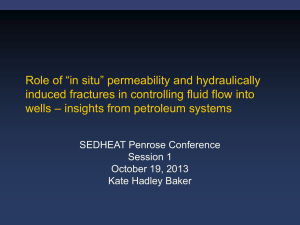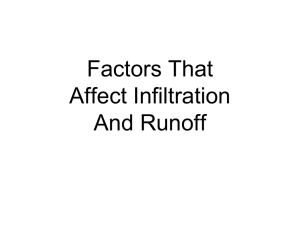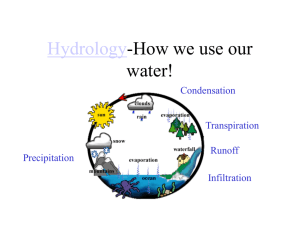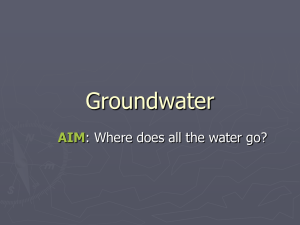dual and triple porosity models from effective medium theory
advertisement
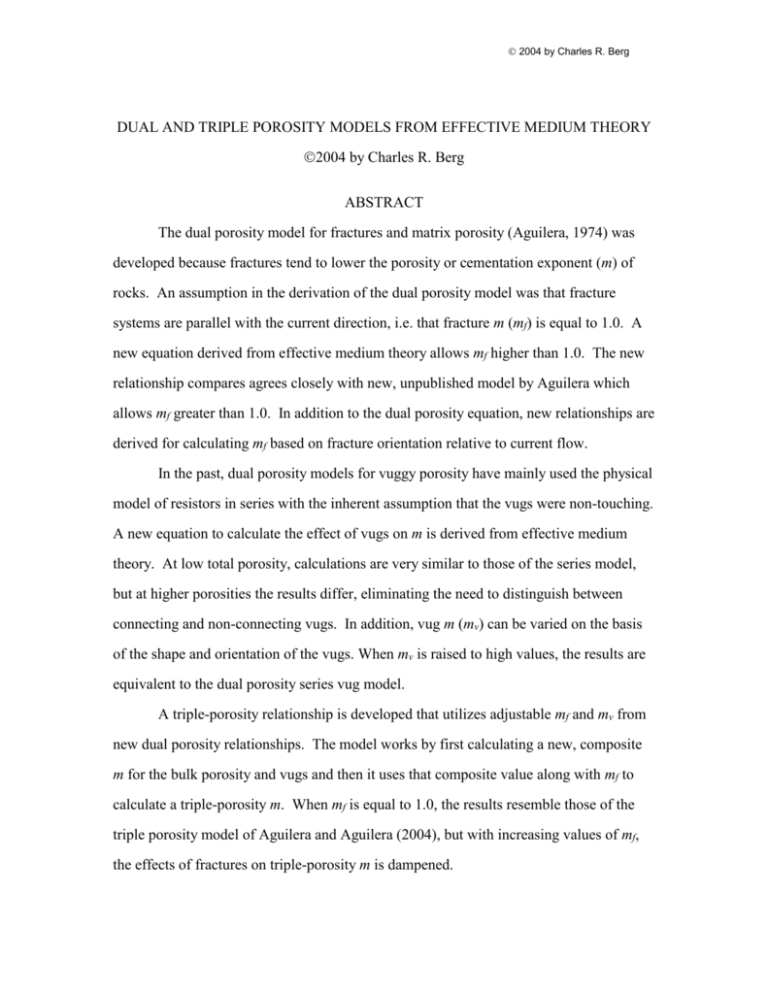
2004 by Charles R. Berg DUAL AND TRIPLE POROSITY MODELS FROM EFFECTIVE MEDIUM THEORY 2004 by Charles R. Berg ABSTRACT The dual porosity model for fractures and matrix porosity (Aguilera, 1974) was developed because fractures tend to lower the porosity or cementation exponent (m) of rocks. An assumption in the derivation of the dual porosity model was that fracture systems are parallel with the current direction, i.e. that fracture m (mf) is equal to 1.0. A new equation derived from effective medium theory allows mf higher than 1.0. The new relationship compares agrees closely with new, unpublished model by Aguilera which allows mf greater than 1.0. In addition to the dual porosity equation, new relationships are derived for calculating mf based on fracture orientation relative to current flow. In the past, dual porosity models for vuggy porosity have mainly used the physical model of resistors in series with the inherent assumption that the vugs were non-touching. A new equation to calculate the effect of vugs on m is derived from effective medium theory. At low total porosity, calculations are very similar to those of the series model, but at higher porosities the results differ, eliminating the need to distinguish between connecting and non-connecting vugs. In addition, vug m (mv) can be varied on the basis of the shape and orientation of the vugs. When mv is raised to high values, the results are equivalent to the dual porosity series vug model. A triple-porosity relationship is developed that utilizes adjustable mf and mv from new dual porosity relationships. The model works by first calculating a new, composite m for the bulk porosity and vugs and then it uses that composite value along with mf to calculate a triple-porosity m. When mf is equal to 1.0, the results resemble those of the triple porosity model of Aguilera and Aguilera (2004), but with increasing values of mf, the effects of fractures on triple-porosity m is dampened. 2004 by Charles R. Berg INTRODUCTION Fractures and vugs can have profound effects on the porosity exponent (m) and calculated water saturation (Sw) of carbonate rocks. Proper prediction of m in reservoirs avoid overestimation of Sw commonly caused by the presence of fractures and also avoid the underestimation of Sw commonly caused by vuggy or oomoldic porosity. Fracture m The original dual porosity equation, as set forth by Aguilera (1974, 1976) and corrected in Aguilera and Aguilera (2003) is as follows: 1 f log f mb b , m log (1) where is the total porosity, b is the porosity of the bulk rock, mb is the porosity exponent of the bulk rock, and f is the fracture porosity in relation to the total volume. The value of fracture m (mf) is not used and is implicitly assumed to be 1.0. In other words the fractures are assumed to contribute in parallel to the whole rock conductivity. The use of parallel resistance implies that the fractures themselves are parallel to the current direction, which is rarely the case. Since fractures inclined to current would give straight-line conductance paths as opposed to the tortuous paths in the bulk porosity, mf should usually be low but not necessarily 1.0. In paper currently in review at Petrophysics, R. Aguilera (2004) has developed an empirical dual porosity fracture equation that allows mf values other than 1. The following equation is his new relationship for mf greater than 1.0: m 1 f mf log f f mb b' m log , Where ′b, according to Aguilera, is the “matrix block porosity affected by mf” and is defined by the equations 2 (2) 2004 by Charles R. Berg ' b f f 1 f f (3) , and f m f (m f 1) log log f . (4) Note that all of the relationships above have been simplified from the original equations by replacing the product of partitioning coefficient and porosity (f) by the fracture porosity (f). Vug m A good example of an existing model for predicting m in vuggy rock is the relationship m log nc 1 nc b mb log (5) from Aguilera and Aguilera (2003, equation 3) where nc is volume fraction of nonconnected vugs relative to the whole rock. Equation 5 was derived using the assumption that non-connected vugs and bulk rock respond to the current flow as resistors in series. As in the fracture equations, the product of partitioning coefficient and porosity (nc) has been replaced by the non-connected vug porosity (nc). Note that there is no porosity exponent for the non-connected vugs. EFFECTIVE-MEDIUM MODEL DEVELOPMENT Fractures The derivations here assume that the matrix grains have zero conductivity. That being said, since m is a geometric parameter the concepts derived here can ultimately be 3 2004 by Charles R. Berg applied to systems where the bulk rock has inherent conductivity such as shales or shaly sands. Effective medium theory has mainly been used for shaly sand analysis and for dielectric calculations, both of which have nonzero matrix conductivity. Use of Archie’s law, generally thought of as an empirical relationship, is justified theoretically when the matrix conductivity is zero, because the equation is a natural result of setting grain conductivity to zero in the effective medium theory used here. Archie’s Law (1943, equation 3) for the bulk rock can be written as R R0b mwb , (6) where R0b is the bulk resistivity and Rw is the water resistivity. Now that the bulk rock has been defined the enclosing fracture system must be defined. In order to define mf other than 1.0, we need a relationship that contains m and that can have nonzero matrix conductivity. Archie’s law cannot be used, but effective medium theory provides just such a relationship. Following is the HB resistivity equation (Berg, 1996, equation 1): 1 R m w R0 R Rr 0 Rw Rr , (7) where R0 is the whole-rock resistivity and Rr is the matrix resistivity. Equation 7 can be used define the bulk rock-fracture system as follows: 1 R mf f w R0 R R0b , 0 Rw R0b (8) where R0b is the resistivity for the bulk rock. This derivation assumes that an expression originally derived for granular material (equation 7) can be used to describe fractures, but that assumption has already been used in previous dual porosity derivations that incorporate fractures into the Archie equation. 4 2004 by Charles R. Berg The term “matrix” when used with respect to the HB equation coincides with its usage in dual porosity nomenclature. Since that is not always the case, “matrix” here will denote only grain properties and “bulk rock” will be the preferred term. To calculate composite m of the whole rock we can use Archie’s law again: R m w R0 (9) When equations 6, 8, and 9 are combined and simplified, we get the following equation f m m mf bmb 1 mb b m mf . (10) An interesting result of the algebra is that R0b and Rw drop out. In other words, this equation retains the property of the other fracture equations (1 and 2) of being independent of Rw. Indeed, when mf of 1.0 is used, the relationship simplifies into equation 1. Unfortunately, equation 10 cannot be solved directly for m, so an iterative method must be used. The zBrent routine from Press, et al., 1996 has been used to find m, but any regula falsi-type algorithm should work. (Regula falsi methods take an equation that has been set equal to zero and try values of the unknown variable until the answer approaches zero.) An alternative method for calculating m is to assume an arbitrary Rw and use equations 6, 8, and 9 in succession to calculate m. Note that when using the HB equation (8) in the stepwise calculation method, it also cannot be solved directly for R0. To calculate R0 from equation 8, it is also necessary to use an iterative algorithm. As in equation 10, regula falsi-type algorithms can also be used to solve equation 8, but Newton-type methods can also be used. To define mf in equation 10 for a set of fractures in one direction is fairly straightforward. Simply put, inclination of the fractures with respect to current flow 5 2004 by Charles R. Berg causes longer current paths and higher resistivity for the whole rock. Following is the relationship for calculating mf: mf log f sin 2 log f (11) Where is the angle between the direction of current flow and the normal to the fracture plane. (See Appendix A for the derivation.) For multiple fracture directions equation 11 can be extended to n log f Vi sin 2 i i 1 , mf log f (12) where Vi are the volume fractions relative to f of each set of fractures, and i are the respective angles which the normal to each fracture set makes to the current direction. Equation 12 does not take into account what happens at fracture intersections, but it is accurate for f at or below 0.1—an extremely large value for fracture porosity (see Appendix A for details). Vugs An interesting property of the HB equation is that the discrete “particles” may be more conductive than the surrounding medium. Vugs and oomoldic porosity present just such a case if the particles in this case are the water-filled vugs and the surrounding bulk rock is the enclosing medium. Following is an adaptation of equation 7 to represent vuggy porosity: 1 R mv R Rw 1 v 0b 0 , R0b Rw R0 where v is the vug porosity with respect to the whole rock and mv is its exponent. Substitution of R0b in equation 13 by equation 6 (Archie’s Law) yields the effective medium dual porosity equation for vugs: 6 (13) 2004 by Charles R. Berg m 1 v mb b 1 mv m 1 m b 1 . b (14) As in the case of the derivation for fractures, the resistivities drop out, leaving a relationship independent of resistivity. Also, as with fractures, equation 14 cannot be solved directly for m. Accordingly, calculation considerations for this relationship are similar to the considerations discussed for the effective-medium fracture relationship (equation 10.) When mv is infinite, equation 14 reduces to equation 5, the series relationship for vugs. This fact fits nicely with the fact that the HB equation reduces to resistors in series when m is infinite, providing symmetry to the fracture relationships where equation 10 reduces to equation 1 when mf is equal to 1.0 (resistors in parallel). The variable mv can thus be used to describe the shape and orientation of vugs. In addition, when mv is close to 1.0, calculations approach that of to equation 1 (the parallel relationship for fractures) but only when mv is below about 1.001. This would seem to indicate that using a parallelresistance relationship for connected vugs as in Aguilera and Aguilera (2003) is perhaps too strong. In other words, even though vugs may be connected, there would still a great deal of tortuosity for the current to contend with until the “vugs” approach the shape of smooth tubes. Spalburg (1988) developed an effective-medium vug equation in which the derivation was the same as the one above up to equation 13 (his equation A-12). However, after that point the derivation differs. A simplifying assumption was that the conductivity of the vugs was always much greater than the conductivity of the bulk rock. To compare to the equations in this study, his equation was adapted to calculate dual porosity m by making Sw 1.0 and substituting m for conductivities. With this modified equation, the results are similar to equation 13 when total porosity is in the range of 10 to 30 percent, but is considerably different below and above that range. In addition, at high 7 2004 by Charles R. Berg values of v, calculated m becomes much too small, even dropping below zero whenv is higher than 97 percent of the total porosity. It is assumed that the difference in the Spalburg’s model and the one presented here is caused by the assumption that the vug conductivity would always be much greater than the bulk conductivity. The new relationship has no such assumption and would be expected to be valid over a wide range of conditions. Vugs and Fractures Together (Triple Porosity) It is not uncommon for vuggy or oomoldic rock to have fractures. Thus there is a need for calculating m under such conditions. Aguilera and Aguilera (2004) proposed just such a model (Fig. 1). Their triple porosity system treats the vug porosity in series with the combined conductivity of the fractures and bulk rock. Another way of accomplishing the same thing would be to first calculate a new “bulk” m and using their vug relationship (equation 5) and then to use the results in their fracture relationship (equation 1). When this was done, the difference in calculated m in the two methods averaged about 1.8 percent over a wide range of variables and the maximum difference between them was 4.8 percent. In a similar manner, the effective-medium triple-porosity calculations (Fig. 2) were performed by first calculating the new bulk porosity using equation 14 as follows: 1 mbv mv mbv 1 , 1 'v bv mb bvmb 1 b b (15) where ′v = v / (1-f), bv = ′v + b (1 - ′v), and mbv is the composite porosity exponent. The following modified equation 10 was then used on the results: f m m mf mbv bv 1 mbv bv m mf . (16) When doing the calculations, the following equation from Aguilera and Aguilera (2004, their equation A-11) is useful: 8 2004 by Charles R. Berg = b (1 – f – v) + f + v. (17) DISCUSSION Fractures The calculations of most of the figures in Aguilera (2004) have been reproduced using both the effective medium fracture equation (10) and Aguilera’s new equation (2). The maximum difference between the calculations was less than 5 percent and was usually below 2 percent. The fact that an empirical equation, which has been derived on the basis of observations of the real world, matches the theoretical equation so well would seem to verify both approaches. Fig. 3 shows the results of varying in the new fracture relationship (equation 11) from 0 to 90 degrees. (Remember that is the angle between the normal to a fracture and the current direction.) A value of of 90 degrees is equivalent to mf of 1.0. The changes at of 60 degrees are fairly small, but the changes at at 30 and 0 degrees are fairly severe. The plot for of 90 degrees is very similar to the plot of series vuggy porosity (discussed below) shown in gray in Fig. 5. This is because when is 90 degrees, the fractures are aligned to the current direction as resistors in series. The high values of dual porosity m at low values of at first glance would not seem to match observed tool response to fractures, which generally indicate mf in the range of 1.0 to 1.3. Note that on Fig. 3, calculated m through of 30 to 90 degrees nearly always lowers m, except for a small increase at high and high f. Tool response must necessarily reflect all of the current directions of the electrical field generated by the tool. For an induction log, for example, current flowing in a circular loop would go through the whole range of in a set of vertical fractures. Although the current might actually flow preferentially through the zones of lower m (distorting the current path to non-circular), we might get a good upper limit to the value of tool-measured mf by averaging calculated 9 2004 by Charles R. Berg m through the loop and then calculating an mf from that average. Fig. 4 shows such an example of calculated m for of 0 to 360 degrees. In this example, mf calculated based on tool response is 1.19, not 1.0 but much lower than the mb of 2.0. The strong directional changes in m exhibited in Fig. 4 could be used to study fracture-induced anisotropy. A logging tool with directed current might be able to measure the anisotropy directly and see the effect of fractures without having to actually encounter them in the borehole. Vugs Fig. 5 shows the relationship of the effective medium vug equation 14 versus the series vug equation 5. At low porosities, the new relationship is nearly identical to the old, but at higher porosities the two diverge, possibly indicating a tendency for more connectedness at higher vug densities. It makes sense that as bulk porosity decreases the result of vuggy porosity looks more and more like series resistance. On the other hand, as the vuggy porosity increases, the vugs should be more and more connected to each other, so the series model would not be accurate. It is possible to use mv to characterize vug shape and orientation, especially since the shape and alignment of vugs may be oriented with bedding or along fractures. Preferential orientation should generally mimic the behavior of the fabric that the vugs are following. Since fractures generally lower m and since bedding can be modeled as resistors in parallel, it is likely that vugs following either fractures or bedding will lower mv. Triple Porosity Systems As discussed above, effective-medium calculations were accomplished by first calculating the new bulk m using equation 14 and then using the results in equation 10 to calculate the triple-porosity m. Fig. 6 shows calculations with input variables the same as in Fig. 2 in Aguilera and Aguilera (2004) and mv = 1.5. The two figures are very similar 10 2004 by Charles R. Berg except for the underlying differences in the vug equations. Fig. 7 shows the effect of changing mf on Fig. 6 from 1.0 to 1.3. The change in mf has significantly dampened the effect the fractures had on the triple porosity equations. CONCLUSIONS The new effective medium relationships for vugs and fractures allow more accurate prediction of water saturation (Sw). The new equation for fracture dual porosity (10) along with the new equation for fracture m (11) will allow modeling of tool response from fractures and the calculation of volume fraction and direction of fractures without actually having fractures cross the borehole. In addition, the fracture model will allow analysis of the effects of fracture-induced anisotropy of rocks. The new vug model (equation 14) eliminates the need for distinction between connected and non-connected vugs. As vugs make up more of the rock volume, they act more “connected” as well they should. This reconciles with the fact that, if there is any intergranular porosity, vugs will necessarily be connected to the bulk rock and not really isolated, hence the series vug model should diverge with observation as vugs become more common. In addition, with the new variable mv, the shape and arrangement of vugs can be taken into account quantitatively. Additional Work Being geometric variables, porosity exponents (m) are as valid for shaly rock as for clean rocks. The principles involved in the derivation of the fracture equation can be used to study fracture-induced anisotropy as well as to study the effects of fractures on Sw in fractured shaly rocks such as the Austin Chalk, since m is a geometric variable. Of course, the Archie equation (9) cannot be used on shaly rocks, but the HB equation (7) can. 11 2004 by Charles R. Berg Instrument response needs to be more rigorously defined for fractures. In order to derive more quantitative relationships from well logs, the effects of fractures on the electrical fields generated by the tools and, in turn, the resistivities measured by the tools must be considered. Although it is likely that most open fractures will have roughly the same orientation, it is possible that in some cases that conjugate sets of fractures might be open. In that case, tool response can be modeled for multiple fractures. NOMENCLATURE Porosity b Porosity of the bulk rock not relative to the whole rock bv In effective medium triple porosity, bulk rock porosity with vug porosity added ′b In Aguilera mf equation, “the matrix block porosity affected by mf” ′v In effective medium triple porosity, vug porosity as a fraction of total porosity not including the fracture porosity f Fracture porosity with respect to the whole rock nc Non-connected vug porosity with respect to the whole rock m Porosity exponent (also cementation exponent) of the whole rock mb Porosity exponent of the bulk rock mbv In effective medium triple porosity, the porosity exponent of bv mf Porosity exponent of the fractures f,v Partitioning coefficient of fractures and vugs, respectively—not used here Angle that the current makes with the normal to a fracture i In the multiple fracture equation, the angle that the normal to each fracture set makes with the current direction Rr Grain or matrix resistivity R0 Whole rock resistivity Rw Water resistivity 12 2004 by Charles R. Berg R0b Bulk rock (excluding vugs and fractures) resistivity Sw Water saturation as a fraction of the total porosity Vi In the multiple fracture equation, each fracture set as a fraction of f 13 2004 by Charles R. Berg Matrix, R0 Non-Connected Vugs, Rw Fractures, Rw Current Direction Fig. 1. Schematic modified after Aguilera and Aguilera (2004) Fig. A-1 showing the electrical model for their triple porosity calculations. The matrix and fractures are together in parallel, while the non-connected vugs are in series with the other two. 2004 by Charles R. Berg Bulk Rock, mb and b mv and v a Bulk Rock + Vugs, mbv and bv mf and f b Current Direction c Bulk Rock + Vugs + Fractures, m and Fig. 2. Schematic showing effective medium triple porosity calculation. Bulk rock properties are from Archie’s law, equation 6. New, composite, bulk rock porosity and exponent (mbv and bv) are calculated using the new dual porosity vug equation 14 by incorporating mv and v. That porosity and exponent are then used in the new dual porosity fracture equation 10 by incorporating mf and f. Blocks a, b, and c are schematics showing the physical model for each step. Block a is grains immersed in water, block b is water-filled holes (vugs) within the bulk rock, and block c is planar fractures within the composite bulk rock. It should be emphasized that the blocks are not simply drawings representing the fabrics—they are schematics representing their respective electrical models. 2 2004 by Charles R. Berg = 60 = 90, m f = ∞ Dual-Porosity Exponent, m Dual-Porosity Exponent, m 1 1.2 1.4 1.6 1.8 2 2.2 2.4 2.6 2.8 3 1 0.001 f = 0.001 Total Porosity, Total Porosity, 1.6 1.8 2 2.2 0.002 0.01 0.005 0.01 0.015 0.02 0.025 0.05 0.1 0.01 0.005 0.01 0.015 0.02 0.025 0.1 0.1 0.05 0.1 1 1 = 30 = 0, m f = 1 Dual-Porosity Exponent, m 1 1.2 1.4 1.6 1.8 Dual-Porosity Exponent, m 2 2.2 1 1.2 1.4 1.6 1.8 2 2.2 2.4 2.6 2.8 3 0.001 0.001 f = 0.001 f = 0.001 0.002 0.002 0.01 Total Porosity, Total Porosity, 1.4 f = 0.0001 0.002 0.005 0.01 0.015 0.02 0.025 0.1 1.2 0.001 0.05 0.01 0.005 0.01 0.015 0.02 0.025 0.1 0.1 0.05 0.1 1 1 Fig. 3. These plots are modeled after Fig. 23 in Aguilera and Aguilera, 2003, with b of 2.0 but using the new fracture equation 10 using fracture angle set from 90 down to 0 degrees. For of 90 degrees (current is parallel to fractures and mf = 1), the results are identical to the parallel dual porosity equation 1. When is 0 degrees (current is perpendicular to fractures and mf = ∞), the results are nearly identical to the effects of series the series model vuggy porosity equation 5 in Fig. 5. This makes sense, because a fracture aligned perpendicular to the current direction should be equivalent to resistors in series and should thus have the same response. 3 2004 by Charles R. Berg Dual Porosity m versus 3 m 2.5 2 1.5 1 0 45 90 135 180 225 270 315 360 dual porosity m average of dual porosity m (=1.88) mf mf calculated from average m (=1.19) b = 0.1 m b =2.0 f = 0.011 Fig. 4. An explanation of how fractures might significantly lower dual-porosity m in spite of the fact that some directions of current flow might exhibit mf much greater than mb. If we assume, for the sake of illustration, that current from an induction log flows in circular paths, it will encounter mf in the range shown using equation 11 assuming a vertical set of fractures. Dual porosity m is then calculated using equation 10 for each angle along the circular path. Averaging this dual porosity m gives a value of about 1.88, close to what might be calculated based on tool response. Using equation 11 on that average yields mf of 1.19. Since the current would tend to flow in lines of least resistance, this hypothetical value might be somewhat higher than the value calculated from actual tool response. Additionally, it is clear from this plot that logging tools that can direct current in a given direction should exhibit strong anisotropy due to fractures. Equation 11 provides a quantitative way of calculating fracture direction and the amount of fracturing in a given well without having to actually encounter fractures in the borehole (or see them in a borehole imager). 4 2004 by Charles R. Berg Vug Porosity Dual-Porosity Exponent, m 2 2.2 2.4 0.001 2.6 2.8 3 v = 0.001 0.003 Total Porosity, 0.005 0.01 0.010 0.015 0.020 0.025 0.050 0.1 0.075 0.100 0.125 1 Fig. 5. Plot of dual-porosity m versus for the effective-medium vug equation 14 (black lines) and the series vug equation 5 (gray lines). For these calculations, b is set to 2.0 for both equations and mv is set to 1.5 for the new equation. Divergence of the two models is small at low porosities, presumably because the vugs have to be unconnected because they are physically so far apart. At higher porosities, vugs becoming more connected to each other would explain lower values of m for the new model. Setting mv to high values makes the new model calculate the same as the series model. 5 2004 by Charles R. Berg Effective-Medium, Triple-Porosity Exponent, m 1 1.2 1.4 1.6 1.8 2 2.2 2.4 2.6 2.8 3 0.01 v =0.01 Total Porosity, v=0.01, f =0.01 v =0.05, f =0.01 0.1 v =0.05 v=0.1 v=0.1, f =0.01 mb =2 mf =1 m v = 1.5 1 Fig. 6. Calculations using the effective-medium triple porosity model. In this case, mf is equal to 1.0. These curves use the same parameters and are outwardly very similar to Fig. 2 in Aguilera and Aguilera (2004), with the main distinction between the two figures being the difference in the series vug equation 5 with the effective medium vug equation 14 (see Fig. 5 for the comparison of the vug models). 6 2004 by Charles R. Berg Effective-Medium, Triple-Porosity Exponent, m 1 1.2 1.4 1.6 1.8 2 2.2 2.4 2.6 2.8 3 0.01 v =0.01 Total Porosity, v =0.01, f =0.01 v=0.05, f =0.01 v=0.05 0.1 v=0.1 v =0.1, f =0.01 mb =2 m f = 1.3 m v = 1.5 1 Fig. 7. Same as Fig. 6, but with mf of 1.3. The change in mf has significantly affected the curves with lower v. 7 2004 by Charles R. Berg REFERENCES Aguilera, R., 1974, Analysis of naturally fractured reservoirs from sonic and resistivity logs, Journal of Petroleum Technology, p. 764-772. Aguilera, R., 1976, Analysis of naturally fractured reservoirs from conventional well logs, Journal of Petroleum Technology, p. 54-57. Aguilera, S., and Aguilera, R., 2003, Improved models for petrophysical analysis of dual porosity reservoirs, Petrophysics, v. 44, no. 1, p. 21-35. Aguilera, R., 2000, Effect of the fracture porosity exponent (mf) on the petrophysical analysis of naturally fractured reservoirs, in review, Petrophysics. Aguilera, R., 2004, Effect of the fracture porosity exponent (mf) on the petrophysical analysis of naturally fractured reservoirs, in review at Petrophysics. Aguilera, R.F., and Aguilera, R., 2004, A triple porosity model for petrophysical analysis of fractured reservoirs, Petrophysics, v. 45, no. 2, p. 157-166. Archie, G. E., 1942, The electrical resistivity log as an aid in determining some reservoir characteristics: Petroleum Technology, v. 1, p. 55-62. Berg, C.R., 1996, Effective-medium resistivity models for calculating water saturation in shaly sands, The Log Analyst, v. 37, no. 3, p. 16-28. Press, W.H., S.A. Teukolsky, W.T. Vetterling, and B.P. Flannery, 1996, Numerical recipes in C[;] the art of scientific computing, New York, New York, Cambridge University Press, 994 pages. Spalburg, M., 1988, The effective medium theory used to derive conductivity equations for clean and shaly hydrocarbon-bearing reservoirs, Eleventh European Formation Evaluation Symposium, Paper O. Towle, G., 1962, An analysis of the formation resistivity factor-porosity relationship of some assumed pore geometries, SPWLA Transactions v. 3, paper C. 2004 by Charles R. Berg APPENDIX A Calculation of mf Derivation of mf is based on the relationship from Ohm’s Law of a cylindrical object R L , A (A-1) where R is the resistance, is the resistivity, L is the length, and A is the cross-sectional area of that object. (The term “cylindrical” here describes an object in which all perpendicular cross sections are congruent.) Fig. A-1 shows cross sections of two identical blocks, one with a fracture system parallel to current flow and the other with a fracture system oblique to flow. is the angle that the normal to the fracture makes with current flow. The bulk rock is assumed nonconductive for the derivation. In order to hold porosity constant, the cross-sectional area in the plane of section of the two fractures must be equal. In other words, the width of the modeled fracture must change with rotation because otherwise the area would not be constant. (The area we are talking about here is not the area in equation A-1, which is perpendicular to both the plane of section and the fracture.) For the top block equation 0 becomes L1 R1 A1 (A-2) and for the bottom block it becomes R2 L2 . A2 (A-3) Dividing equation 3 by equation 2 we get L2 R2 A 2 . L1 R1 A1 (A-4) As stated above, the cross-sectional area of the fractures must remain constant and thus 2004 by Charles R. Berg L1 T1 L2 T2 . (A-5) Note that the cross-sectional areas A1 and A2 are cross sections of the fractures at perpendiculars to the same fractures and not to the cross-sectional plane of Fig. 1. Since the thicknesses T1 and T2 are proportional to A1 and A2, then L1 A1 L2 A2 . (A-6) follows from equation 5. Solving for A2 in equation 6 and then substituting that result into equation 4 and simplifying we get 2 R 2 L2 . R1 L1 (A-7) Since resistivities and resistances should be proportional for same-sized blocks, 2 R02 L2 , R01 L1 (A-8) where R02 and R01 are the resistivities of their respective blocks. For the upper block, m = 1, so Archie’s law reduces to R01 Rw , f (A-9) Rw . m f f (A-10) and for the lower block Archie’s law is R02 Substituting equations 17 and 10 into equation 8 and substituting sin for L1/L2 we get log f sin 2 mf , (A-11) log f which is equation 11 in the main text. Equation A-12 has been rigorously tested by single-fracture models at various angles using equations A-1 and 9. Using resistors in parallel, equation A-11 can be extended to the following relationship: 2 2004 by Charles R. Berg n log f Vi sin 2 i i 1 . mf log f (A-13) where Vi are the volume fractions relative to f of each set of fractures, and i are the respective angles which each set makes to the current direction. (Equation A-13 is equation 12 in the main text.) When equation A-13 is extended to 3 orthogonal, equalporosity sets of fractures to compare to Towle’s (1962) relationship for the anisotropy if such a system, the equations are very similar in form except that in Towle’s relationship the sin terms are not squared. Following is Towle’s relationship for calculating formation resistivity factor (-m): F' 2 F , sin sin sin (A-14) where F is the formation resistivity factor for vertical current flow and F′ is the formation resistivity factor for inclined current where , , and are the angles that normals to the fractures make with the current vector. Extension of equation A-11 to three sets of orthogonal fractures using resistors in parallel gives 3 f F' . sin 2 sin 2 sin 2 (A-15) With vertical current flow and with f below 0.1, equations A-14 and A-15 yield a maximum difference of 2.0 percent. At f of below 0.01, the maximum difference is less than 0.1 percent. The relationship for F in A-14 (not shown here) is exact below f of about 0.5, while the derivation of equation A-15, does not take into account what happens at fracture intersections. It is assumed from the similar forms that the derivation for Towle’s equation (A-14) may not have held f constant, and thus the sin terms are not squared. Indeed, Towle admitted that “The expressions concerning the anisotropic nature of the systems have not been verified in the rigorous mathematical sense.” Therefore it is assumed that “sin2” can be substituted for “sin” in equation A-14. An interesting 3 2004 by Charles R. Berg consequence of this relationship is that there is no anisotropy in this orthogonal system since sin2 + sin2 + sin2 is equal to 2.0, no matter what the current direction. Thus equation A-14 would reduce to F' F , (A-16) and equation A-15 reduces to F' 3 . 2f 4 (A-17) 2004 by Charles R. Berg Fractures Parallel to Current Flow Bulk Rock Current Flow T1 L1 Normal Fracture Fractures Oblique to Current Flow Normal Bulk Rock T2 Current Flow L2 Fracture Fig. A-1. Two blocks, the top one showing a fracture parallel to current flow and the bottom one showing a fracture oblique to current flow. In order to maintain constant porosity, the area of the fracture in the plane of section must remain constant, and thus the thickness must change with the length. Perpendicular area of fractures, A1 and A2 (not shown) are of width T1 and T2 going into the page. The angle is the angle that the normal to the fracture makes with the current direction. 5
